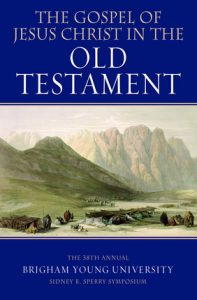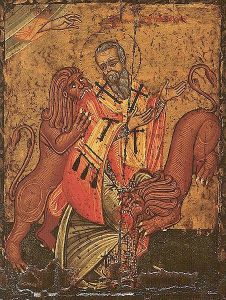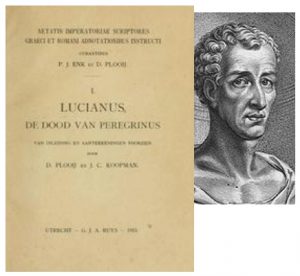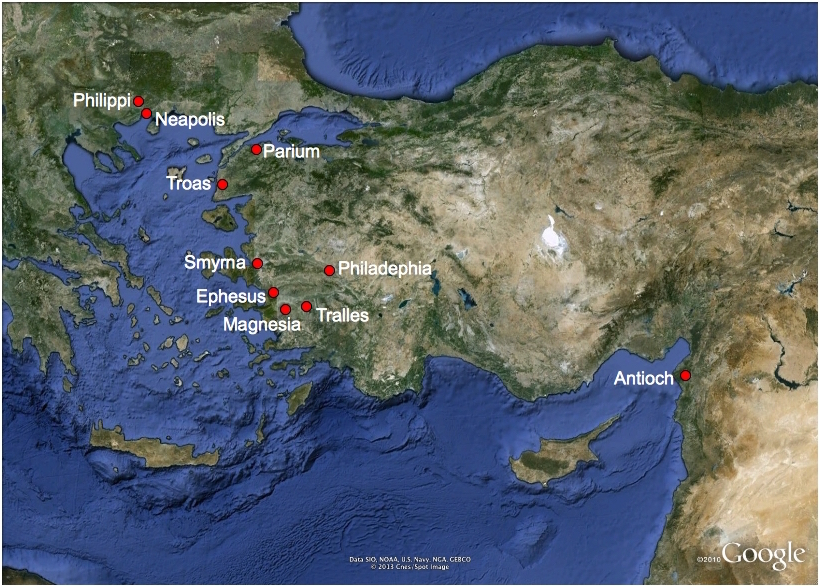*
Earl Doherty’s Response to Bart Ehrman’s Case Against Mythicism – Pt. 12
Three Voices on the Historical Jesus – No. 2: Ignatius of Antioch
.
COVERED IN THIS POST:
- What does “truly” mean for Ignatius:
- anti-docetism?
- historical fact?
- Ignatius knows no Gospels, even in 110 CE or later
- implications of this
- rumours of an allegorical tale interpreted as history
- no teachings of Jesus, no miracles,
- no apostolic tradition
- Why did docetism arise in Ignatius’ time?
- two reactions to the historical Jesus
- A Christ myth in Ignatius’ Ephesians
.
* * * * *
Evidence for Jesus from Outside the Gospels
(Did Jesus Exist? pp. 101-104)
Ignatius of Antioch
.
Did Ignatius write the Ignatian Letters?
Bart Ehrman seems to assume the authenticity of the story that Ignatius was caught up in a persecution of Christians at Antioch around 107-110 CE, was condemned to death and sent to Rome under military escort to die in the arena. Along the way, he wrote letters to six churches in Asia Minor and one to bishop Polycarp of Smyrna.
Many doubt the feasibility of such an enterprise, including the likelihood that the authorities would have undertaken to send him all the way to Rome for execution. But that is the story told in later tradition, and it is to be found within the letters themselves.
I will not go into the arguments for and against authenticity here, but if they are later forgeries (that is, the versions known as the “Shorter Recensions” which have traditionally been considered the originals, with the Longer Recensions coming much later in the century and filled with obvious insertions based on the Gospels), such forgeries cannot have been made much later than a decade or two after Ignatius’ death. (I myself might opt for forgery, but I will continue to refer to the writer as “Ignatius.”)
.
Arguing for a “true” life on earth
One of the principal purposes of these letters is to attack fellow Christians who espouse doctrines and practices Ignatius cannot countenance. Ignatius makes a set of claims about Jesus which he declares to be true, in opposition to those who deny them. The fullest statement of these claims is found in the epistle to the Smyrneans (as translated by Ehrman):
For you are fully convinced about our Lord, that he was truly from the family of David according to the flesh, Son of God according to the will and power of God, truly born from a virgin, and baptized by John that all righteousness might be fulfilled by him. In the time of Pontius Pilate and the tetrarch Herod, he was truly nailed for us in the flesh. . . [Smyrneans 1-2]
How does Ehrman (and scholarship traditionally) interpret a passage like this? What is Ignatius arguing for and what is the position of those he criticizes? According to Ehrman, the latter are
. . . Christians who insisted that Jesus was not a real flesh-and-blood human. These opponents of Ignatius were not ancient equivalents of our modern-day mythicists. They certainly did not believe that Jesus had been made up or invented based on the dying and rising gods supposedly worshipped by pagans. For them, Jesus had a real, historical existence. He lived in this world and delivered inspired teachings. But he was God on earth, not made of the same flesh as the rest of us. (p. 102)
In other words, Ehrman sees Ignatius’ opponents as docetists (from the verb dokein, to seem), holding the doctrine that Jesus only seemed to be human, only seemed to possess a body of human flesh. In reality, this was only an illusion; he was and remained in spiritual form, so that he did not partake of human nature and did not suffer on the cross.
But is this the meaning that can reasonably be taken from some of Ignatius’ statements? Continue reading “12. Earl Doherty’s Response to Bart Ehrman’s Case Against Mythicism – Pt. 12. Three Voices . . . Ignatius”
Like this:
Like Loading...







